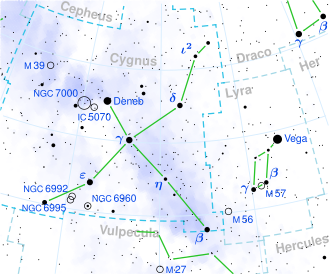Location of GJ 1245 in the constellation Cygnus | |
| Observation data Epoch J2000 Equinox J2000 | |
|---|---|
| Constellation | Cygnus [1] |
| GJ 1245 AC | |
| Right ascension | 19h 53m 55.142s [2] |
| Declination | +44° 24′ 44.39″ [2] |
| Apparent magnitude (V) | 13.46 / 16.75 [3] |
| GJ 1245 B | |
| Right ascension | 19h 53m 55.141s [4] |
| Declination | +44° 24′ 54.15″ [4] |
| Apparent magnitude (V) | 14.01 [3] |
| Characteristics | |
| Spectral type | M6V / M8V [5] / M6V [6] |
| Variable type | UV Cet [7] |
| Astrometry | |
| Radial velocity (Rv) | 3.93±0.38 [4] km/s |
| Proper motion (μ) | RA: 349.363(56) mas/yr [4] Dec.: −480.322(54) mas/yr [4] |
| Parallax (π) | 214.5745±0.0476 mas [4] |
| Distance | 15.200 ± 0.003 ly (4.660 ± 0.001 pc) |
| Absolute magnitude (MV) | 15.12 / 18.41 [5] / 15.72 [3] |
| Orbit [8] | |
| Primary | GJ 1245 A |
| Companion | GJ 1245 C |
| Period (P) | 6,147±17 days |
| Semi-major axis (a) | 0.8267±0.0008″ |
| Eccentricity (e) | 0.334±0.002 |
| Inclination (i) | 135.7±0.1° |
| Longitude of the node (Ω) | 261.2±0.2° |
| Periastron epoch (T) | 51506.8±2.1 |
| Argument of periastron (ω) (secondary) | 36.1±0.2° |
| Details | |
| GJ 1245 A | |
| Mass | 0.120±0.001 [5] M☉ |
| Radius | 0.146±0.007 [5] R☉ |
| Luminosity | 0.0014 [5] L☉ |
| Temperature | 2,927 [5] K |
| Metallicity [Fe/H] | −0.07 [5] dex |
| Age | ~300[ citation needed ] Myr |
| GJ 1245 C | |
| Mass | 0.081±0.001 [5] M☉ |
| Radius | 0.087±0.004 [5] R☉ |
| Luminosity | 0.0003 [5] L☉ |
| Temperature | 2,611 [5] K |
| Metallicity [Fe/H] | −0.08 [5] dex |
| GJ 1245 B | |
| Mass | 0.115 [9] M☉ |
| Radius | 0.142 [9] R☉ |
| Luminosity | 0.00123 [9] L☉ |
| Surface gravity (log g) | 5.20 [9] cgs |
| Temperature | 2,865 [9] K |
| Metallicity [Fe/H] | −0.05 [10] dex |
| Rotation | 0.71 [11] days |
| Rotational velocity (v sin i) | 7 [11] km/s |
| Age | 3.1 [10] Gyr |
| Other designations | |
| V1581 Cyg, GJ 1245, WDS J19539+4425 | |
| GJ 1245 AC: G 208-44, LHS 3494, NLTT 48414, KIC 8451868, 2MASS J19535443+4424541 [12] | |
| GJ 1245 B: G 208-45, LHS 3495, NLTT 48415, KIC 8451881, 2MASS J19535508+4424550 [6] | |
| Database references | |
| AC | |
| B | |

GJ 1245 (Gliese 1245) is a double star with components G 208-44 and G 208-45, located 15.2 light-years (4.7 parsecs ) away in the constellation Cygnus. G 208-44 is itself a closer double star made up of two red dwarfs, while G 208-45 is also a red dwarf. GJ 1245 is the 43rd closest stellar system to the Solar System. [14] GJ 1245 A and B are both active flare stars, [15] and the pair are collectively designated V1581 Cygni. [16]
Contents
The largest of the three stars, GJ 1245 A (G 208-44 A) is only 12% the Sun's mass. [5] Of the other two stars, GJ 1245 C (G 208-44 B), is closest to star A at 2 AU away; [17] it is 8% of the Sun's mass. [5] The third star, GJ 1245 B (G 208-45), is 27 AU away from star A, [17] and is estimated to complete an orbit every 279 years. [18] It is slightly smaller and less luminous than GJ 1245 A. [9]
